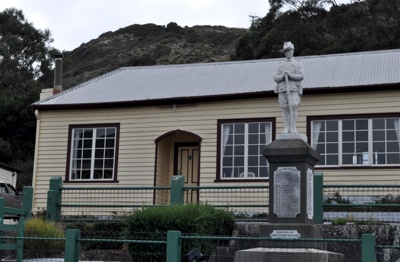 The main street in Stanley, with the Nut behind.
The main street in Stanley, with the Nut behind.
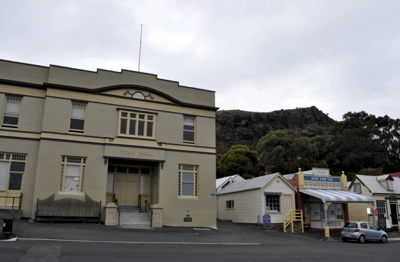 The main street in Stanley, with the Nut behind.
The main street in Stanley, with the Nut behind.
 Descending Stanley's Nut via the chairlift.
Descending Stanley's Nut via the chairlift.
The Murchison Highway at Hellyer Gorge was a lot of fun.

Over-speed alarm (centre), with our tour guides Joel and Kate at Dove Lake, Cradle Mountain.

The restored Mount Lylle ABT Railway, just out of Queenstown, before it starts the 1 in 16 climb towards Strahan.
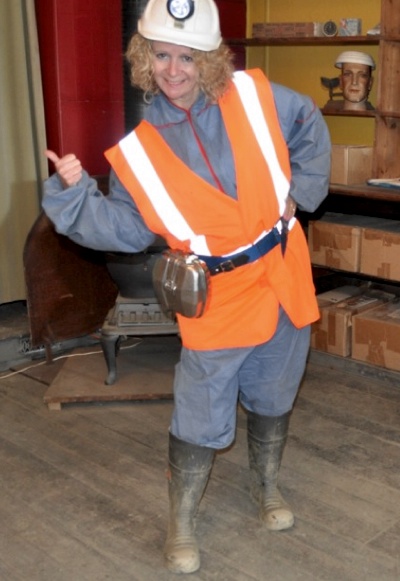
Miner for a day. Wearing the proper kit and learning about underground safety before the descent.
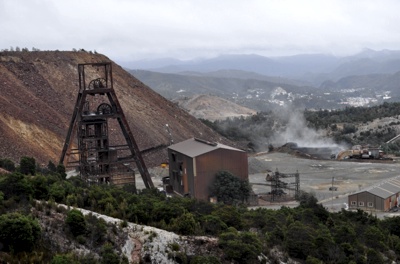
The only part of the mine visible from above.

2 kilometres underground with tour guide Anthony from the Mount Lyell Underground Mine Tour. Its worth every cent, and bookings are essential.

The wonderful Cherry Villa at Hamilton. Built by the convicts, as it seemed was the entire town.
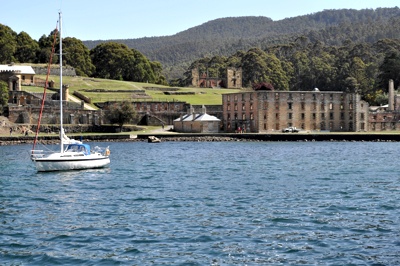
The beauty of Port Arthur.

Bicheno was a great place to relax. But then, so was the rest of Tasmania.

The MX5 on the wonderful Elephant Pass Road. We had it to ourselves.
By the time we reached the Elephant Pass Road, we were completely chilled out. Even our choice of music had changed.
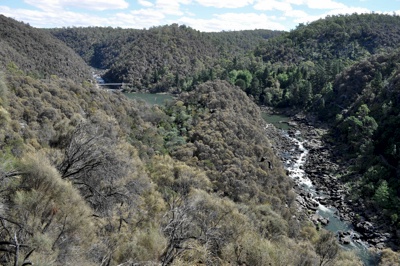
Launceston's Cataract Gorge, from the Zig Zag track.
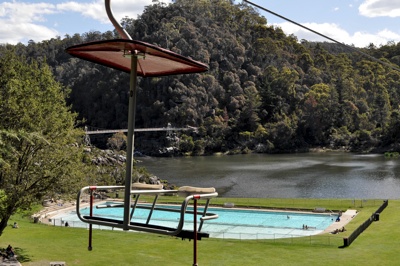
Crossing the South Esk River via the worlds longest single chairlift span.

No visit to Launceston would be complete without a visit to the National Automobile Museum of Tasmania.
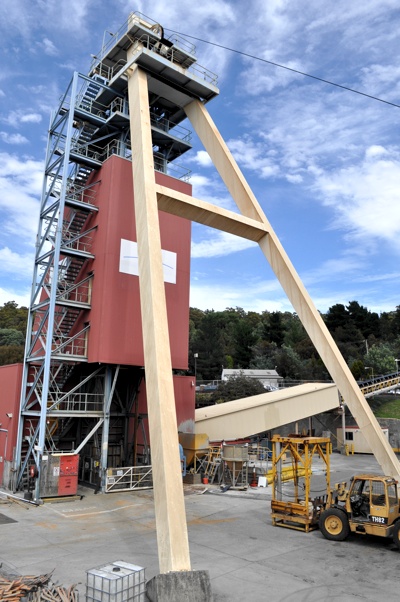
The Beaconsfield Mine. Still operational, the museum is well worth the visit. But, once you have done the Mount Lyell Underground Mine Tour, it all seems a bit too passive.
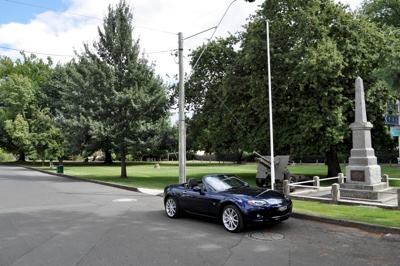
If you enjoy reading about Australian history (and there isn't a lot of it) "Crack Hardy" and the story of the Searle brothers will likely give you a whole new perspective on the ANZAC's. We detoured to Westbury to find the war memorial at the Village Green - and pay our respects.

For our last night in Tasmania, we had the whole house to ourselves, complete with spa bath. Its a short drive from Deloraine back to Devonport.
|
Spirit of Tasmania
With so much time spent behind the keyboard, and not the wheel, it was time to hit the open road and enjoy what Australia has got to offer. We are Melbourne based, and for some reason we always point north when selecting a holiday destination, and so it took some convincing to persuade the co-driver (actually, she didn’t drive at all, but did operate frequently as an over-speed alarm) that we should go south. It was also a little self indulgent. My maternal side of the family originates from Queenstown, Tasmania.
My great-grandfather was the fireman on the now restored Mount Lyell ABT railway, and my grandfather worked the open cut mine prior to heading off to France in the closing stages of World War 1. We booked the Spirit of Tasmania, and once aboard were immediately impressed with the facilities on offer. For an overnight voyage, the restaurant, cinema and numerous bars were perfect. Of more concern for a car tragic was that the car was safe and sound down in the hold. It was, and any concerns I had about the vehicle staying in good shape were quickly dispelled.
Onboard the Spirit and my co-driver was quick to befriend some "Wild Hogs", a band of leather-clad bikers who were going on their annual tour of Tasmania's east coast. To be honest, I wouldn't have called them the Wild Hogs, leastwise not to their face, but
it seemed no deterrent to her. We enjoyed listening to their riding tales, although not many seemed all that legal. Surprisingly, as my co-driver went to the bar to buy another round, the Wild Hogs looked over to me and whispered "Geez mate, you've got your hands full with that one". They were right.
Stanley
By the time we drove off the Sprit, through quarantine and onto the highway it was around 8am. We switched on the Satnav and dialed in Stanley. Men are, apparently, visual creatures. And so it was that, after consulting various maps, I actually had no idea of distances and times - as that would have required reading the map, instead of simply looking at it. But I was pretty confident we would make Stanley by nightfall – which is always a good thing when you have nothing booked. Our Satnav was purchased in Munich, Germany, and had seen service directing us from the Eagles Nest at Berchtesgaden, to Nuremburg, and on to Berlin.
Now loaded with Australian maps, I was pretty confident that it could do the job, even though we had determined the thing was made by “Bastards-R-Us”. But suddenly I had a sinking feeling, as “Bastards” was telling us we would arrive in Stanley at 9:40am. Putting it down to a system malfunction, we pressed on towards Burnie, and what was to be our lunch stop. Noah and the Whale was the chosen music, the first of many I assumed we would be listening to as we headed west. But, seemingly only a few tunes into the album, we passed the “Welcome to Burnie” sign. Over-speed alert exclaimed “Wasn’t Burnie meant to be our lunch stop?”.
Obviously we were making good time, so a decision was made to instead stop for breakfast. A quick tour around town and we felt we had seen all that was needed, so back in the car and onward to Stanley. “Bastards” the Satnav had revised its ETA and added an extra half hour. We decided that it must have still been using German time. The drive west was pleasant enough, wide open roads that are not very demanding, and a wonderful absence of traffic we would soon become accustomed to. It was a little disappointing that it was raining, and so our intended wind-in-the-hair holiday was starting out with the roof up.
Nevertheless we were starting to relax, and enjoy the clean Tasmanian air. It was time to put the car on autopilot, so I engaged the cruise-control and settled back. Seemingly moments later a sign appeared, and as I got closer I could see it read “Welcome to Stanley”. I suddenly remembered my Tasmanian friend Lenny telling me that, to see Tasmania, all I needed to do was drive to the top of Mount Wellington. I had the funny feeling he would have been laughing at me right about now. Finding accommodation was our first problem, particularly given we had arrived in town well before most had checked out, let alone had rooms cleaned. In fact, most people were probably still asleep.
We settled on a lovely B&B, situated just down the road from the cemetery. Stanley is a beautiful little town, and almost next door to where we were staying was one of the original Stanley pubs, operating from 1820 to 1954. Long since converted into a home, we were starting to understand why so many fall in love with the apple isle. No concrete and glass monstrosities to be seen – it was always easy to picture it as it was 50, 100 or even 150 years earlier. Catching the chair lift to the top of the Nut, then walking the 2km track around it is well worth the effort too.
Cradle Mountain
Day 2 and we headed to Cradle Mountain. The weather was starting to clear up, which meant the roof came down. The roads were also starting to get a little more interesting – and by the time we made Deep Creek Road there was a smile on the dial, the little MX-5 reveling in the twisty stuff. The Murchison Highway through the Hellyer Gorge was brilliant, and allowed the car to demonstrate how well sorted and balanced it was. By this time we had started to trust Bastards the Satnav too, so were pretty confident we would make Cradle Mountain by lunch time. Once we had settled in to our accommodation, which consisted of a bed and tv stand, without a tv, we headed out on the first of our three tours. The evening “Spotlight” tour was arguably the strangest we had ever been on. The fact that I nearly tripped over a Pademelon when walking out the front door of the Lodge should have been a clue.
Once we had been loaded into the Toyota 4x4 transporter, we travelled less that a metre when we came to an abrupt stop, to spot what would be the first of many wallabies and wombats. I am not for a minute trying to say that seeing so many wonderful animals in their native environment was in any way disappointing – quite the contrary – it was fantastic to see them thriving. But, for those who have seen National Lampoons European Vacation, you will understand when I say, once we had seen the umpteenth wallaby, “Look kids, Big Ben!”.
The next day we set out on a canoe tour of Dove Lake. I was pretty keen to hook up with the tour guide, Joel, who I figured would be a deft hand when it come to canoe mastery. Instead, I was lumbered with Over-speed Alert. I shouldn’t complain, the weather was great and we were told that the actual mountain is hidden by clouds for more than 200 days a year, so we were lucky to have such a beautiful day to paddle around. It took us a few hours, and we had time for morning tea and a walk among the King Billy Pine. We soon discovered the Tasmanians are very proud of their Pine trees.
Strahan
The drive from Cradle Mountain to Strahan saw us continue along the Murchison Highway – and that was a good thing. The road is in pretty good condition, the views provided are spectacular and every so often there is that little yellow sign that warns of twisty roads ahead –if you own a MX5 I bet you are smiling – because you know what that means. Lunch at Zeehan and onto Strahan, and that’s when we ran into our first difficulty – there may as well have been a huge “No Vacancy” sign above the place. That’s not quite true, there were two small rooms still available, but at just under $300 a night it was above our budget, so we settled on a lovely room on the other side of the bay, overlooking Strahan.
Once settled, it was back to the pub – where we soon discovered why Strahan was at capacity. Our cunning plan to travel at the end of February, when the school holidays were over, had been stolen by thousands of grey nomads. There were motorhomes in their hundreds – and the pub was doing a roaring trade. The motorhome fraternity are a friendly bunch, even if they are a pest on the roads. Looking out across the beautiful Strahan harbor I spotted the chef walking back from a fishing trawler, carrying the evenings “fish of the day” – and in Strahan that means Ocean Trout. Delicious, and one of the best meals had during our journey – although by the end of the holiday we were convinced that Tasmania is a seafood lovers paradise.
The next day we caught the Coach to Queenstown for the return trip via the restored Mount Lyell ABT railway, which these days is called the West Coast Wilderness Railway. I have always wondered what the difference is between a bus and a coach – the only one I can think of is a coach has more comfortable seats. This did, so coach it was. At around $100 per person for the trip the railway is not a cheap trip, but by the end of the day I doubt anyone thought it bad value. It is always more fun to travel with friends, and we were quick to join up with Kingsley and Jill from Wellington in South Australia, just near the mouth of the mighty Murray river.
Setting out from Queenstown, we travelled the original route which takes you through some of the most spectacular country Australia has to offer. When the railway was built in the late 1800’s the engineers were faced with the difficulty of getting the copper ore to the port of Strahan. The terrain would represent an almost impossible scenario today, so the fact that the engineers achieved it over 100 years ago is a miracle. Clinging to the side of the mountains with the help of viaducts and bridges, the train winds its way slowly up the 1 in 16 gradient, following the spectacular Queen river.
And that river is worth a small mention. For over 80 years it was the main carrier of mining residue and the local sewage. It is estimated that 100 million tonnes of tailings were disposed of into the Queen River. This in turn flowed into the lower part of the King River, and then into a delta at the mouth of the river where it met Macquarie Harbour. The first stop is at the early settlement of Lynchford ,where a gold mine and other mining activity supported a small community in the early days of the railway. The train continued to drag itself up the mountains via the ABT system, then down toward Regatta Point on Macquarie Harbor.
The following day we travelled the Gordon river into the wilderness, where we gained an understanding as to why so many had put up such a fight to save the Franklin river. We owe them, and the Hawke labor government our thanks. But the beauty of the wilderness was not the only point of interest. Sarah Island, Australia’s original convict settlement was a fantastic stopover point, where we were entertained with a very theatrical guide of the island and its turbulent past. As you stand on the island, you cant help but think that the proximity to the mainland would hardly stop a would be escapist, but apparently the convict inhabitants were all very poor swimmers. But there were a few that could swim, including this countries very first serial killer - Alexander Pearce.
Queenstown
We arrived back in Strahan mid afternoon and headed in to Queenstown. One thing you will notice when you travel in this part of Tasmania is that the road signs do not just indicate distance, but also travel time – the roads are so windy that you will never get anywhere near the speed limit. We arrived in time to spend a few hours at the Queenstown museum – a converted pub that is now home to a huge collection of artifacts from the towns mining past. To be honest, you could spend a day there – but I was on a mission to see if I could find any trace of my grandfather. And there it was, his name on the Queenstown World War 1 honor roll.
The next day we set off on the Mount Lyell underground mine tour. Anthony was our tour guide – amazingly knowledgeable, he had spent most of his life working in the mine, enabling him to provide a first hand description of what life was like as a miner. To take the tour you need to start with a comprehensive safety drill, and even kit up with the correct equipment including miners hard hat and light, oxygen mask, boots and safety vest. Anthony takes safety very seriously, and given what happened to Larry Knight, Brant Webb and Todd Russell at Beaconsfield we could understand why. You are also issued with a temporary miners dog tag, which you use to check in and out of the mine. Those familiar with the Beaconsfield mine disaster will remember the first thing that Webb and Russell did when they reached the surface was to remove their tags from the tag board.
We got to see the original open cut that my grandfather worked on, and then proceeded down the 2 kilometers to the bottom of the mine. It was just our luck that, on the day of the tour, the mine had shut down for maintenance. There are apparently only 3 days each year this occurs – so the chances are that if you take the tour, you will see the mine in full operation. But even with the mine shut down, there was still plenty of action occurring underground, with maintenance and repairs being carried out by the miners and the pumps busy extracting the vast amount of underground water. Anthony told us that Queenstown has an average annual rainfall of 3 metres, so removing water is a 24 hour a day requirement.
At around the 1 kilometer underground mark we passed the elevator – the point we would need to reach to find safety in the event of an accident underground. Down and down we went, often pulling in to small alcoves to allow larger trucks and their crews past. At around the 2 kilometer mark (that’s 2 kilometers underground – we had travelled a lot further than that to get that deep) we were shown the safety refuge, where in the event of an emergency you need to ascend the ladder to get to the elevator. That’s around 1 kilometer worth of ladder climbing.
Derwent Bridge and Hamilton
After the tour we drove east towards our next stop, Hamilton. While it was threatening to rain, it didn’t stop us from driving topless. The windy road out of Queenstown is akin to what you would expect the surface of Mars to look like. Barren, red and inhospitable, it was strangely beautiful in its own way. But the effects of acid rain did not stretch too far, and we were once again travelling through some spectacular countryside. The Lyell highway to Derwent Bridge is a brilliant stretch of road, enough to keep a driver entertained while being able to take in the majesty of the forest. In fact, the only disappointment was that we were travelling through it so quickly. Car parks were seemingly full of motorhomes where the occupants had set out to do some trekking in the wilderness.
At Derwent Bridge we pulled in to take a look at “The Wall” – a giant mural carved from wood. To give you some idea of its size, you can purchase a glass of wine while you wander along the two large installations. To be honest it wasn’t my taste in art, but I am still glad that I saw it. Onwards to Hamilton, which looks big on the map but is more a hamlet than a town. You can do your own walking tour in around 30 minutes, and inevitably you will end up at the pub, and likely run into some more grey nomads.
And it was there that we met some fellow travellers, who had been on the road for 5 years. They had started out with a caravan, but quickly switched to a motorhome when they realized the convenience and cost effectiveness that a motorhome can provide. Equipped with solar panels and a generator, they were completely self sufficient, and a Vespa allowed them to travel into town if additional supplies were needed. While we were only on our 5th day in Tasmania, they were into their 5th month, and were yet to do the east coast. After meeting these guys, the idea of travelling around Australia in a motorhome seemed a whole lot more appealing.
Port Arthur
The drive from Hamilton to Port Arthur was nice enough. Our intention was to head into Hobart, but the One Day International being played at Bellerive Oval meant there was, again, no accommodation available. "Bastards" guided us around the perimeter of Hobart, through Richmond and onto Port Arthur. From the little we saw of Richmond it looked like a great place for a stop-over - it also has Australia's oldest surviving bridge.
It was a brilliant day weather wise, and would have offered a perfect photo opportunity, but time was against us. The roads were in good condition, and the closer we got to Port Arthur, the more interesting the scenery. We made good time (although a plethora of hire cars were content to sit well below the speed limit) and were fortunate to arrive before midday. It was starting to warm up and we would have ended up looking like a couple of middle-aged lobsters had we stayed in the sun any longer.
Much has been written about Port Arthur and its convict past. I guess that’s the main attraction of the place. But these days the grounds are resplendent and it was the perfect place to unwind after a couple of hours behind the wheel. To be honest, the pace of Tasmania is a lot slower than what we are used to on the mainland, so perhaps we were only now starting to acclimatise. One reservation I did have before going was the legacy left by mass murderer Martin Bryant.
Any concerns were quickly dispelled, and I had completely forgotten about the idiot while we roamed around the ruins, took the cruise and joined foghorn-leghorn on the walking tour...”Keep Up At The Back”. The interpretation centre provides you with a playing card, and once inside you find which convict your card represents. It is a great idea, by following the journey of one inmate from transportation to internment makes the experience much more personal. Near the end of the day we did stumble upon the ruins of the Broad Arrow Cafe – what they have done by way of a memorial is terrific and honours the fallen beautifully.
Hobart
The following day we headed back to Hobart, where we managed to secure a couple of nights accommodation. First up was a visit to the Salamanca Markets – where much of the produce is local, fresh and very tasty. We even drank some locally produced lemonades to wash it down. We noted that there were a few low-brow Chinese knock-off stands, but not enough to ruin the fun. Lets hope it stays that way, and does not lose any of its character. After the market we headed to Constitution Dock and what we felt was a well earned bevvy. The temperature gauge was hovering around 39C, not a temperature we were expecting so far south. As we sat drinking, we looked across to a large ice breaker. With the sweat dripping off us it seemed, just briefly, that the Antarctic was a better option.
The following day we went to Mona - Museum of Old and New Art. It is very difficult to describe the place, and there are much better artistic scribes that can do that. But what I can say is that we caught the very first ferry over, and the very last ferry back – and if time had of permitted we would have returned. While there we bumped into a friend who had travelled over with his girlfriend to see the cricket. Disappointment was written all over their faces – apparently her sister was a model for one of the installations that was not on display that particular day.
In a case of foot-in-mouth, over-speed alarm enquired which one that was. This site is “G” rated, so I cannot publish the answer – but we were left wondering how you would ever put that on your resume. And if, from the many that made up the artwork, they were expecting to have been able to pick it out. The only good thing about leaving Hobart was the knowledge that we could easily return for a weekend later on. There was so much left undiscovered, including Mount Wellington itself.
The East Coast and Bicheno
The drive to Bicheno was a lot of fun. The roads are in good condition, with enough hills to keep you entertained. We noticed a lot more motorcycle traffic, and there were even road signs declaring the area “motorbike friendly” – whatever that means. I was enjoying the drive so much that we overshot Wineglass Bay on the Freycinet Peninsula. Over-speed alarm was probably on the lookout for her old friends, the Wild Hogs. Whatever the case, before we knew it we found ourselves in Bicheno. We checked in to some accommodation and headed to the blowhole. When I saw it I realised I should have doubled back. There is not much to say about the blowhole. But Bicheno is a nice enough place - peaceful like pretty much the rest of Tasmania.
The next day we decided to cut inland and head toward Launceston. And that meant we would travel the Elephant Pass. In fairness I had been told just how good it was, so my expectations were pretty high. And I was not disappointed. We were the only car on the road, the sun was shining, the countryside spectacular and I had slowed down a whole lot. Even the choice of music had slowed down, to sometime in the 70's. Perhaps Tasmania was starting to get into the blood. Behind the wheel I could not think of any place on earth I would have rather been. The Elephant Pass Road takes you to St Marys, where you join the main highway to Fingal and on to Launceston. One of my great regrets will be that I did not do a u-turn, and do the whole thing again.
Launceston
Launceston is old. But sometimes old can be good. If you are on this site, then the chances are you like old cars...and the same goes for cities too. We were told Launceston is the third oldest city in Australia, preceded by Hobart Town and Sydney Town. Just up the Tamar is an old pub which was owned by one John Batman, before he sailed to the mainland on the schooner Rebecca. After exploring much of Port Phillip, he found the current site of central Melbourne, noting in his diary of 8th June 1835, "This will be the place for a village." He named the place "Batmania", which is kind of cool. And this was a long time before Bob Kane penned the life and times of the caped crusader in Gotham City.
Accommodation was yet again another problem. We had lobbed into town just before the Launceston Cup, with plenty of fillies flying in from the mainland to partake in the race carnival. Once we had located possibly the very last room available, offering a breathtaking view of the guests laundry, we set of for Cataract Gorge. And this is where I can offer some advice. There are, as we were soon to discover, two tracks leading to the gorge. The first, and the one most sane people would take, offers an easy walk along the ravine. The other, known as the “Zig-Zag Track”, follows a path across the top of the gorge. So my advice? Do not take the Zig Zag track.
But, of course, I had no idea what lay ahead and, using my well honed map reading skills, I thought the Zig-Zag track sounded like fun, and so we set out and climbed, and climbed. Over-speed alarm was starting to fall behind, and was less than impressed that any tourist attraction would require so much effort to get to, particularly as she had chosen to wear flip-flops. Knowing she needed encouragement, I went ahead and yelled back that I could see a restaurant, and better still, it was licensed. “I guarantee they will have Chardonnay” I would yell back. I was praying that there would be a restaurant, and that it would be licensed. The fact that I have lived to write this account proves that there was – but for a time my life hung in the balance. It was worth the effort – the place itself is beautiful. A chair lift took us to the other side, where we took the easy stroll back to the hotel.
Launceston is not without things to do. We took the Tamar river cruise, and checked out the Launceston Motor Museum. Unfortunately we missed the Boags tour, and there are various walking tours you can do around the town. But the thing that will strike you about Launceston is just how well preserved the place is. Story has it that, while much of Australia prospered during the 1950s and 1960s, Launceston did not enjoy the spoils. And so, while the rest of Australia was busy pulling down anything considered old fashioned, Launceston was left alone - and how lucky the current day residents are.
Beaconsfield, Westbury and Deloraine
Unfortunately our time in Tasmania was drawing to a close. With only one night left, we headed north through the Tamar Valley to visit the Beaconsfield mine. Fortunately for the residents of the town, the mine remains operational. There is a wonderful museum where you get to see the history of the area and the mine itself. From there we backtracked to Westbury, to pay our respects to the Searle brothers, whos story comes to life in the wonderful book "Crack Hardy".
If you enjoy Australian history, and what the young ANZAC boys endured on the beaches of Gallipoli and the trenches of France, then put this on your must read list. We then drove on to Deloraine, where we secured arguably our best accomodation of the entire trip - and given the difficulty we were having getting any accomodation at all we considered ourselves very lucky. Deloraine is the gateway to Cradle Mountain, but in our case we needed to continue north to Devonport, and our berth aboard the Spirit.
So the wrap-up. Would we travel to Tasmania again? Absolutely. Would we recommend it to our friends, or you our valued web visitor? Without hesitation.
The round trip saw us travel around 1500 kilometres, and 1400 of them were amazing. Great roads seem to abound, there is very little traffic and, in many places, you feel like the whole island is yours. Being the sole travellers along the Elephant Pass Road was an experience we will never forget. We made up our minds early into the trip that we would need to return. To do Tasmania justice, you need to spend a lot more than 2 weeks driving around the island. But 2 weeks will provide you with a wonderful holiday. The west coast was our favourite, the Wilderness Railway, Mount Lyell Mine Tour and Gordon River Cruise the highlights.
The roads were all in good condition and fun to drive. Importantly, the MX5 did not suffer at all, no stone chips or collateral damage. If I could find any fault with the roads, then it would be that much of the West Coast are coarse chip. Road noise is one of the weaker points on modern day Mazda's, so maybe we noticed this a little more than most. But in any case, it was a small price to pay, the MX5 rewarding at every opportunity. But I think that you would enjoy the experience no matter what you drove. Safe Travelling.



